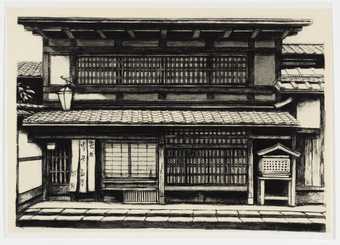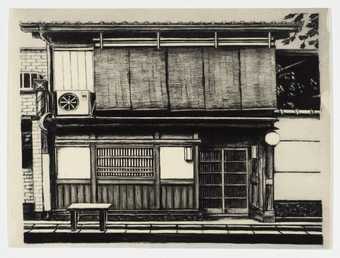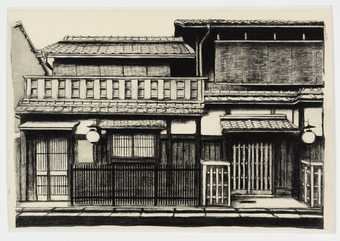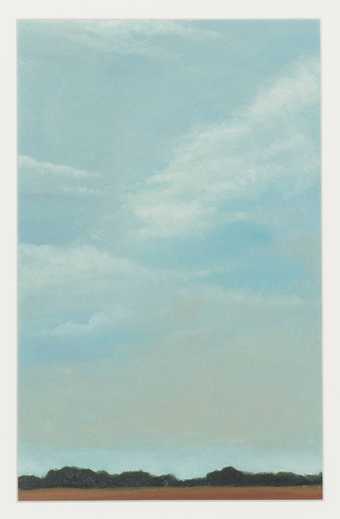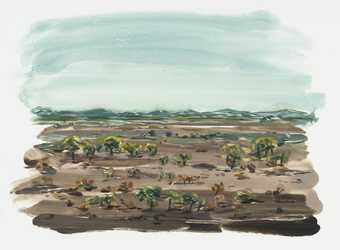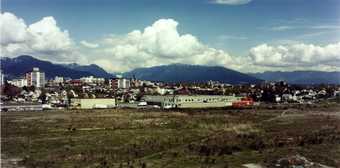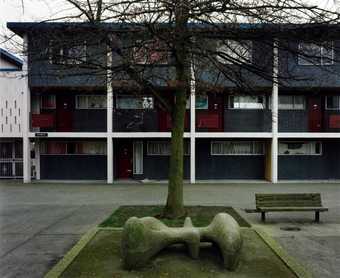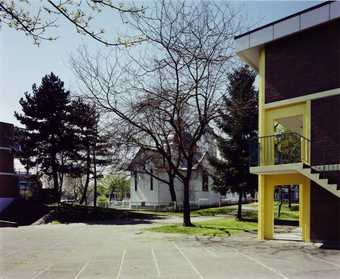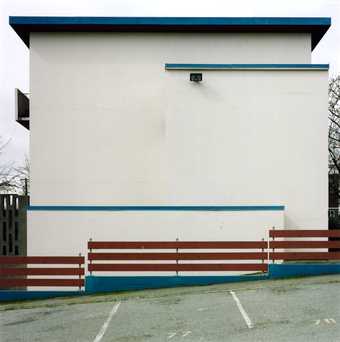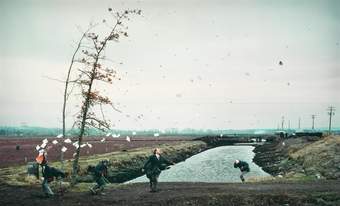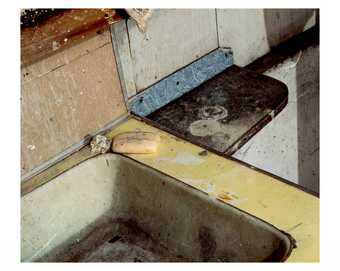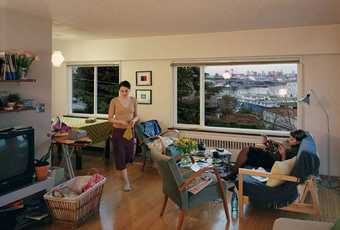
In Tate Modern
Exhibition
- Artist
- Jeff Wall born 1946
- Medium
- Transparency on lightbox
- Dimensions
- Support: 773 × 1215 mm
frame: 883 × 1321 × 59 mm - Collection
- Tate
- Acquisition
- Purchased 1997
- Reference
- T07235
Summary
Wall created this collage of photocopied photographs and paper to assist his working process in the making of A Sudden Gust of Wind (after Hokusai)
1993 (Tate T06951). The completed work is a large back-lit photographic transparency depicting four figures frozen in attitudes as they respond to a gust of wind in a flat, open landscape. The sky above them is scattered with papers released from a folder held by the woman on the left side of the picture. Wall has used the sense of movement across the image from left to right, resulting from the dispersal of papers and other evidence of the wind’s direction, as a device to engage the viewer’s eye and move it over the photograph. To make the work, Wall photographed actors over a period of five months in a landscape outside his home town, Vancouver, at times when similar weather conditions prevailed. He then collaged elements of the photograph digitally in order to achieve the desired composition. The result is a tableau which appears staged in the manner of a classical painting. The Study clarifies various aspects of Wall’s method. It shows the landscape in black and white, the four figures superimposed on it and above them, the series of papers in the sky, each marked with a red cross and annotated with numbers. Wall has explained that he used this study,
for working out aspects of the composition. It was done by photocopying black and white scan outputs, enlarging them, and patching them together. The main purpose was to plot out the position and sizes of the papers blowing in the air. I took individual pieces from the various original scans, copied them, and stuck them on the paper, changing them around to make the composition of the sky. This took quite a while, and the small pieces were moved around repeatedly. Each has a code number, so I could trace them back to a sheet of film. So the collage was really a working element in making the picture.
(Faxed letter to Tate curator, February 1997.)
The Study is crossed by a grid of diagonal, vertical and horizontal lines to aid the artist in mapping the positions of the picture’s components. Two spindly trees on the left side of the image are collaged from another piece of paper. They are presumably not in their final positions as the trunk of the smaller one is misaligned near the base, indicating places where the artist cut and paste. To the left of the trees, a patch containing three small figures working the bare fields was also reworked for the final image; only one figure remains. Close comparison between the study and the work reveals shifts in the positions of the pages, highlighting the process of experimentation carried out in creating the composition. Wall trained initially as a painter at the University of British Colombia, Vancouver. After completing an MA in 1970, he moved to London to undertake doctoral research in art history at the Courtauld Institute (completed 1973). His work is based on his extensive knowledge of classical painting theories and techniques. Formal composition is central to his practice. He began using digital collage to make his photographs in 1991.
Further reading:
Else Barents, Jeff Wall: Transparencies, Munich 1986
Jeff Wall, exhibition catalogue, Chicago Museum of Contemporary Art, Galerie Nationale du Jeu de Paume, Paris, Whitechapel Art Gallery, London 1995, pp.14-15
Kerry Brougher, Jeff Wall, exhibition catalogue, Museum of Contemporary Art, Los Angeles 1997, pp.26, 34 and 124-5
Elizabeth Manchester
July 2003
Does this text contain inaccurate information or language that you feel we should improve or change? We would like to hear from you.
Explore
- architecture(30,960)
-
- bridges and viaducts(4,123)
-
- bridge(3,989)
- industrial(2,075)
-
- canal(589)
- townscapes / man-made features(21,603)
-
- telegraph pole(103)
- formal qualities(12,454)
-
- diagrammatic(799)
- photographic(4,673)
- artifice(96)
- environment / nature(315)
- recreational activities(2,836)
-
- walking(144)
- reading, writing, printed matter(5,159)
-
- paper(80)
- Canada(54)
You might like
-
Lisa Milroy Kyoto House
1996 -
Lisa Milroy Kyoto House
1996 -
Lisa Milroy Kyoto House
1996 -
Lisa Milroy Sky
1997 -
Lisa Milroy Sky
1997 -
Lisa Milroy Ostriches
1997 -
Lisa Milroy African Landscape
1997 -
Stan Douglas Strathcona and False Creek Flats
1998 -
Stan Douglas McLean Park and False Creek
1998 -
Stan Douglas Biomorphic Sculpture at McLean Park
1998 -
Stan Douglas Russian Orthodox Church at Stamps Place
1998 -
Stan Douglas Abstract Composition
1998 -
Jeff Wall A Sudden Gust of Wind (after Hokusai)
1993 -
Jeff Wall Diagonal Composition
1993 -
Jeff Wall A View from an Apartment
2004–5

